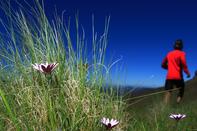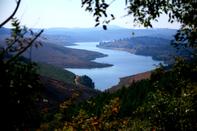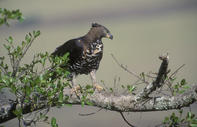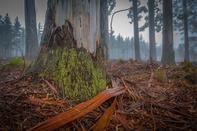Magoebaskloof Hiking Trail
The Magoebaskloof Hiking Trail consists of two separate circular routes, namely the Dokolewa and Grootbosch sections. They are laid out as an elongated figure eight with the first 10 km of each taking the same route from the De Hoek forest station near Tzaneen.

Grootbosch Forest is the biggest Afro-montane or yellowwood forest north of the Garden Route. The thing is, most of us are not used to that amount of forest and, quite frankly, it gets really creepy in there. Day one is amazing.
Walking completely enshrouded in dripping greene is incredibly exciting - with lichens, ferns, coloured fungi, lush clivias growing in the forks of massive trees and the craak craak of turacos (louries), always just out of sight.
On the second day you just cannot believe there is this much forest in Limpopo. But by the third day claustrophobia starts to set in, and you realise just why we celebrate our sunny skies so much. In the dim half-light you feel terribly alone and vulnerable and you start to understand those scary stories about wolves and witches in the forests.
Fishing

If you're one of those crazy bass fishers, chances are you'll know Ebenezer Dam. It looks much more like a lake in the Alps than a dam in Limpopo, situated as it is among pine plantations above the head of forest-cool Magoebaskloof.
If it's bass you're after, the deep, clean mountain waters of this Groot Letaba River impoundment is one of only a few places 'up north' that yield both large- and small-mouth species. Just why anyone would want to catch a bass when there are rainbow trout in the same waters remains one of the enigmas of human evolution, but there it is.
There is a lovely, green campsite on the shore, but you'd best be able to talk fish if you want to get on with your fellow campers.
Birding

Woodbush Forest Reserve (30 km from Tzaneen) and Rooikoppies raptors’ site are particularly good birding spots in Magoebaskloof. The reserve boasts magnificent vegetation that holds it’s own against many other pieces of Afromontane forest.
Granted, the trucks and logging are a pain and the forest is not all that accessible, but you’re bound to have exceptional birding here, and at the nearby bat-hawk stakeout.
Throw in Debegeni for its beauty – and some Cape parrots, black-fronted bush-shrikes, orange thrushes, green twinspots, crowned eagles and cuckoo hawks – and you have the perfect birding day.
Did You Know?

The area is named after the Sotho chief Magoeba, who tried in vain to stem the invasion of fortune seekers, hunters, woodsmen and farmers that followed the discovery of gold here in the early 1870s. The tribesmen harassed the miners and burned farmhouses.
In retaliation the Boer government sent a force of nearly 900 mounted commandos and artillery, plus a few hundred Swazi and Shangaan mercenary troops to deal with Magoeba. He retreated with his warriors into the Grootbosch forest and for a year defied attempts to dislodge him. The commandos were so hampered by the hellish terrain, dense forest, rains and mist that they called it 'Helsche Bosch'.
Eventually, in June 1895, the forest was extensively shelled, Magoeba's kraal captured and razed, and the chief (so the story goes) beheaded by Swazi mercenaries. Magoebaskloof is also home to what has been reputed to be the tallest tree in South Africa. Last measured in 1998, the blue gum (Eucalyptus saligna) in the Woodbush Forest Reserve in Magoebaskloof reaches almost a 100 m into the sky.
By David Bristow